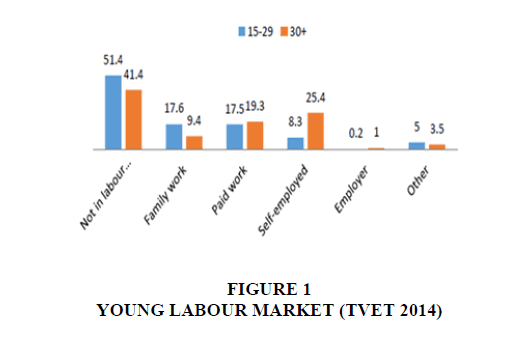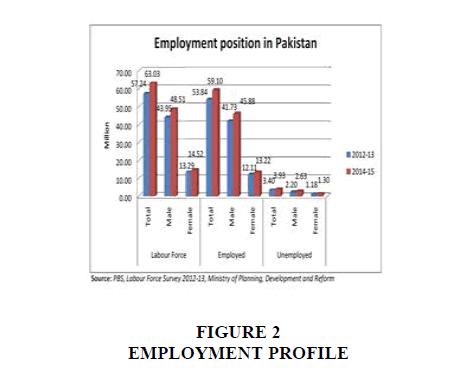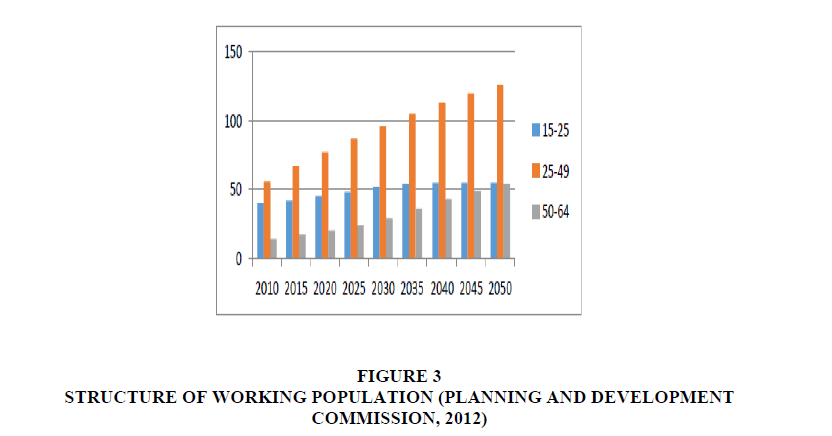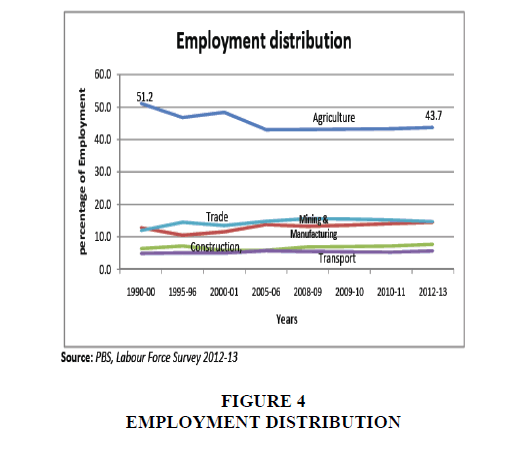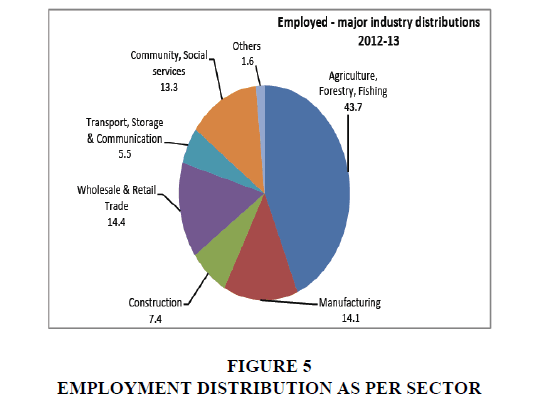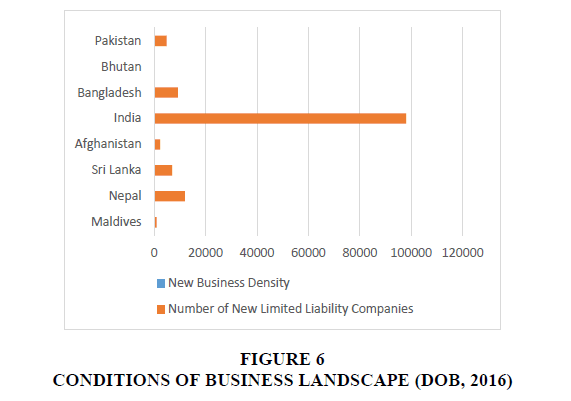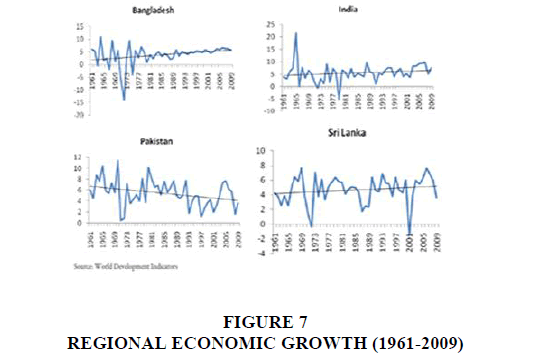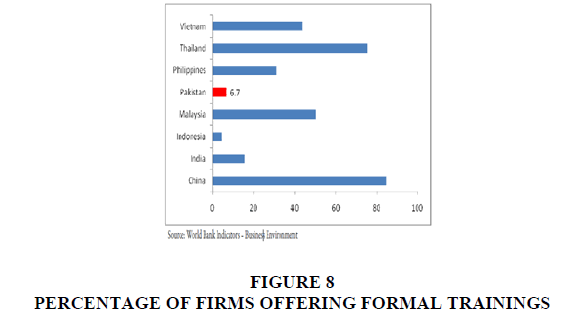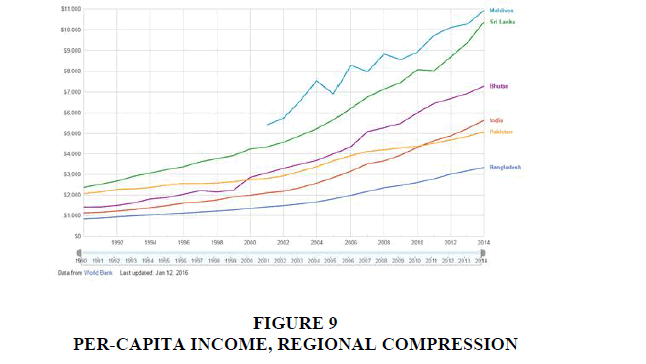Research Article: 2018 Vol: 24 Issue: 3
Entrepreneurship and Skills Development For Socioeconomic Growth Present Landscape and Future Agenda for Pakistan
Muhammad Salman Shabbir, Universiti Utara Malaysia
Mohd Noor Mohd Shariff, Universiti Utara Malaysia
Yasameen Hamzah Alshaibani, Al-Qadisiyah University
Muhammad Faisal, Lahore University of Management Sciences
Dr. Rabia Salman, Universiti Utara Malaysia
Keywords
Skills, Socioeconomic Development, Human Capital, Entrepreneurship, Governance.
Introduction
According to Global Employment Trends (2017), International Labour Organization reports the dynamics of entrepreneurship is reshaping across the world as more female and young entrepreneurs entering the market. Entrepreneurship has now been widely considered as a fundamental engine for job creation and economic growth (Mcquaid, 2002). Davidsson (2006) established that research studies have been indicating the positive link between entrepreneurship and growth of any country. Economic development strategy using entrepreneurship as a tool had become very common in the last two decades (Walzer & Athiyaman, 2007; Ali et al., 2017; Ali et al., 2016; Anwana and Akpan, 2016; Eisa and Sin, 2015; Acs & Armington, 2004; Audretsch & Fritsch, 2002). Entrepreneurship has now been interconnected to innovation and economic growth and considered as the fifth factor of production (Kirzner, 1973; Schumpeter, 1934).
Nations with skilled human capital are proactive in adjusting more proficiently in response to the challenges of local and international markets (International Labour Organization, 2008; Ministry of Skill Development and Entrepreneurship, India 2015). Human capital generally referred to skills development, education, health and other capabilities of any individual which can have an impact on efficiency (Mayan and Nor, 2017; Manaf and Ibrahim, 2017; Jalloh and Guevera, 2017; Wong, 2016; Todaro, 2002). Furthermore, human capital and socioeconomic development are highly correlated and integrated (Ellis & Wang, 1994). Therefore, human capital and skills development are being considered the integral conditions for socioeconomic development (Global Entrepreneurship Research Association, 2017; The World Bank, 2018). Also, several research studies have been indicated that human capital and skills are more important than physical capital for socio economic development of any country (Abbas, 2001; Lucas, 1990; Barro, 1990; Ellis & Wang, 1994) and recognized human capital and skills development as driving factors for socioeconomic development of any developing country like Pakistan (Walzer & Athiyaman, 2007; North, 1990; Aron, 2000; Coase, 1992).
Numerous studies have been addressed the role of skills and human capital development in different contexts (Kocak et al., 2017; Farnicka, 2017; Farnicka, 2017; Intezar, 2017; Khan and Aslam, 2017; Mayan and Nor, 2017; Khan et al., 2015; African Development Bank, 2011; Florida et al., 2008; Barro, 1991; Mayer, 2000; Benhabib & Spiegal, 1994) Likewise, an empirical research study carried out by Abbas (2001) resulted in quantifying the role of skilled human capital on economic development. The study was performed in Pakistan and Sri Lanka with the aim to determine similarities or differences among two under developed nations. The results of the study confirmed that skilled human capital was a vital part in the socioeconomic growth.
The paper is structured as; the next section provides some insights into population and employment trends of Pakistan. The third section focuses on institutional and stakeholders’ support followed by a section on regional and international comparison on different socioeconomic parameters. Section five covers existing initiatives taken by Government of Pakistan for skills development. Finally, section six provides some implications, conclusion and recommendations in the Pakistani context.
Population of Pakistan a Strategic Resource or a Labiality?
Pakistan was established in 1947 after a dubious partition of India, Governments have been trying to build skills and human capital for economic growth, but the first thoughtful and foremost effort arise when Mr. Zulifaqr Ali Bhutto came into power and nationalize all educational institutions with the moto to educate all free of cost which will leads to skills and human capital (Haque, 2007). Irrespective of the fact whether Bhutto was able to deliver what he promised or not he was able to export a considerable number of skilled, semi-skilled and unskilled Pakistanis to different countries, which were able to increase international remittances back home and become one of the earning hand for the nation. Although, at that point the surplus human capital was exported but afterwards it caused brain drain from Pakistan.
Pakistan is one of the most crowded countries of the globe with projected population of 191.71 with estimation to reach at 227 million in 2025 (Vision 2025-Planning and Development Commission of Pakistan, 2015). According to the Labour Force Survey 2012-13, unemployment rate is 6.24%, while 10.5% is reported in young population. This increasing rate of unemployment is alarming with the intense increase, which is anticipated. Surprisingly, 63% of total population is less than of 30 years of age (World Bank 2016; Planning Commission of Pakistan 2015) providing a great opportunity for development using this young human resource to harness the challenges and opportunities of local and global market. Figures 1 and 2 explain the trend of young labor market and employment profile of Pakistan.
The claim had also been supported by Planning and Development Commission of Pakistan (2010) while estimating the working population between the ages of 25-49 will be doubled in the structure of working population for 2050. Pakistan is blessed with young population, which can be utilized through mobilizing and encouraging youth for self- employment, which in turns lift economic growth and development. This provides a great opportunity to utilize this young population to increase productivity and growth at national level.
It is also important to consider that overall economic structure of Pakistan, which is more agriculture focused (Labor Farce Survey, 2013). One of the primary reasons is rural urban divide of total population that is highly rural centric with approximately 64% of population belongs to rural areas. One of the major earning sources of the rural population is perhaps agriculture and agriculture related occupations and industries (Figure 3).
Figure 4 shows the employment distribution among major sectors of Pakistan where agriculture is leading with a great margin (Labour Force Survey, 2013). Furthermore, 43.7% of the overall portion of Pakistan’s economy based on agriculture, forestry and fishing.
The employment distribution shown in Figure 5 indicates a high dependability on one sector and demands a great transition worldwide as developed nations which have already transformed their focus from agriculture to industrial to information and most recently to knowledge based economy (OECD, 1996; Time, 2000; UNICEF, 2002).
Entrepreneurship, is however, remained very limited in Pakistan (GEM, 2012; Haque, 2007). According to World Bank's report (2007) and GEM (2012), entrepreneurship activity in Pakistan was much lesser than the other developing nations, such as Sri Lanka, Bangladesh, and India and compared to other Asian countries as well. Pakistan is ranked at 138th among 189 countries on the level of ease of doing business (The World Bank, 2018). According to the Global Entrepreneurship Monitor (2012), the nascent entrepreneurial activity (NEA) is reported at lowest level in Pakistan. Additionally, the overall businesses are run on very small scales as compared to other regional counterparts (DOB, 2018). Moreover, the Indian small and medium sized businesses are less vulnerable to fiscal and ecological instabilities. On the other hand, the business community in Pakistan depends for initiatives, policy making, and planning from Governmental side. Despite of striving, they are more interested in rebates, subsidies and tax reliefs for business community (Qureshi et al., 2012).
Figure 6 explains the present conditions of business landscape which shows the new business density and entrepreneurial weaknesses in comparison with counterpart nations. Additionally, the overall businesses are running on very small scales as compare to other regional counterparts (DOB, 2016). Moreover, the Indian Small and Medium Sized businesses in comparison with Pakistan are less vulnerable to fiscal and ecological instabilities. On the other hand, the business community in Pakistan waits for initiatives, policy making and planning only from Government side. Despite of striving, they are more interested in rebates, subsidies and tax reliefs for business community.
Institutional And Stakeholder Support
Institutional and stakeholder support are vital elements for socioeconomic growth and human capital development of any nation (Hall & Jones, 1999). Skills development is not a process which can take place in isolation, rather it is an integrated and coordinated effort of various institutions and stakeholders (Acemoglu et al., 2001). On a contrary Global Competitiveness Report (2015) highlighted the most problematic factors for doing business in Pakistan. One of the most alarming is the score of corruption marked as a second highest after inadequate supply of infrastructure at the top (DOB, 2016).
According to the report (DOB, 2016), institutional and stakeholders’ Support and overall governance structure reflect poor conditions in Pakistan. If the agenda is to promote entrepreneurship and skills development initiatives, there is a great need for institutional and stakeholders’ support mechanism (Shabbir et al., 2016: 2016a: 2016b: 2017). World Bank (2013) had identified 10 most important constrains for doing a business in Pakistan, while corruption was also among one of the top reasons. Government should need to take drastic measures to control this evil and come up with a unique strategy. Corruption seems to be reported consistently as a great hurdle for economic development and growth. Keeping in view the facts discussed, there is an urgent need to boost entrepreneurial ventures through a favorable institutional support system from all stakeholders particularly from Government. In order to enhance self-employment and skills development, an auspicious stakeholder support mechanism is utmost important.
Regional And International Comparison
Pakistan is located on a very critical place of the map of the earth. Surrounded by two of the world’s largest nations, it had been centered of attention in global politics since its creation. It has the potential to have an impact on China, India, Russia and Central Asian states merely due to its existence and location. Blessed with great natural resources and its strategic location as compare to other regional nations, one could assume the potential of growth that Pakistan is capable of, but the real picture is showing adverse facts, the overall economic growth is on lower side with decreasing trend when compare to India, Sri Lanka and even Bangladesh is growing faster than Pakistan. Figure 7 is indicating regional growth trends from 1961 to 2009.
Training and development has been recognized as a key tool for skills and human capital development (World Bank, 2010). According to the World Bank report on business environment, Pakistan was standing on seventh position with total eight participants. Only 6.7% firms were offering formal training for skills development which will lead to an effective and efficient human capital. Pakistan score was only more than Indonesia on this indicator as per Figure 8. Likewise, per capita income in Pakistan is extremely very low if compared with other similar regional countries as portrayed in below cited diagram. This sounds alarming for strategy makers that nations like Maldives, Bhutan, India and Sri Lanka are way ahead and performing considerably better than Pakistan (World Bank, 2016).
Government Initiatives For Skills Development
It has widely been accepted that entrepreneurship contributes immensely in less developed and growing economies by generating of employment and ultimately socioeconomic development (Wennekers & Thurik, 1999). Therefore, in recent years, the Pakistani government has acknowledged the role of entrepreneurship for economic growth (Planning and Development Commission of Pakistan, 2013). The government of Pakistan has placed special attention to promote entrepreneurship in Pakistan through different seminars and workshops. In Pakistan, small and medium sized organizations contribute 40% of the GDP of Pakistan and these companies provide 80% employment to the total non-agricultural labor force either as sole proprietor or working as a family business (Small and Medium Enterprise Development Authority, 2010). Nonetheless, Chaudhry (2004) concluded that small enterprises played an important role in poverty reduction and employment generation in the country. On the other hand, it has been observed that small business ventures in Pakistan are facing a severe deficiency of resources, lack of financial support from Government and financial institutions and technological issues causing slow growth of entrepreneurial activities in Pakistan (Bhutta, 2000; Sarfraz & Mian, 2011; GEM, 2013). National Vocational & Technical Training Commission (NAVTTC) has been directed by Federal Government to train 25,000 young graduates in more than 195 market-oriented courses under Prime Minister’s Youth Skill Development Program. The initiative aims at helping fresh graduates to attain the required skills for better job hunt and this will also minimize the gap between skills level of graduates and expectations of the employers (Shabbir, 2009; Shariff et al., 2016: 2016a). Working on similar lines, The National Training Bureau (NTB) is aimed at sharpening the skills of 3,000 trainees. This initiative was expanded in form of public private partnership with the overall aim of 34,000 skills trainees. National Internship Program initiated by Government of Pakistan is also helping youth of Pakistan enhancing their skill level and ultimately increasing human capital of Pakistan (Abidin et al., 2015; Abidin & Haseeb, 2015: 2018; Haseeb, 2018; Haseeb et al., 2014).
Higher Education Commission (HEC) is also working for enhancing the skills and knowledge level by offering competitive scholarships both indigenous and international level for master’s and Doctoral studies. The major focus of these scholarships is on science and technology related fields which are more applied in nature. This initiative is assisting Pakistan two folds, firstly the skills level is improving and coming at par with current global knowledge level and secondly, it is increasing overall literacy rate in the country See Figure 9.
Implications And Recommendations
Keeping in view the discussion made on socioeconomic growth, Government of Pakistan need to take drastic measures to enhance the skills level of nation with special emphasizes on being self-employed. Based on above mentioned facts and global trends, following are some of the recommendations for Government and policy making institutions;
1) Should draft a national policy for skills development and entrepreneurship after taking all stakeholders on board.
2) Integrated national level plans for skills development should be composed, breaking these plans to program level should be designated to respective ministries and departments.
3) Governance structure should be revamped on war footing bases.
4) Eradication of corruption should be assured from Government officials.
5) Support at institutional level must be provided to Entrepreneurial ventures to promote self-employment culture.
6) Universities and academic institutions should train business graduates with the aim of “Job Creators” rather than “Job Seekers”.
7) Universities and academic institutions should maintain a close liaison with Industry to assess the recent skills level requirement of the employers and modify the curriculum accordingly.
8) Small and Medium Enterprise Development Authority (SMEDA) should be made more vibrant, supportive and proactive in initiating policies and strategies for boosting entrepreneurial ventures and sharing latest global trends to the nation.
9) Institutional initiatives like Technical Education & Vocational Training Authority (TEVTA), Punjab Information Technology Board (PITB) and Punjab Skills Development Fund (PSDF) should be benchmarked across the country.
10) Skill Development Council (SDC) should be allocated more funds to operate on wider level.
11) Supporting polices and rules should be place for small and medium sized businesses to boost economic development.
12) Government bodies make sure that large MNCs and small and medium sized businesses should co-exist to ensure market competition.
13) Improved and easy access to finance for new business ventures.
14) Drastic measures must be taken for enhancing the tax paying population to increase national revenues.
According to World Bank’s report on Public Expenditure Management in Malaysia (1999), certain guidelines and insights were shared to be taken as benchmark for developing and less developed countries like Pakistan. Malaysia has applied latest management and governance concept in executing government functions for better service delivery to public. This transition has greatly improved the efficiency of government offices, public trust and confidence was greatly boosted. Cohesive result-based management system was also employed for long term planning for national growth and capacity building. Pakistan can use Malaysian model and use same management and governance concept that helped Malaysia gain drastic and fast growth both of economic and social aspect of the national life.
Conclusion
Based on the facts presented in this paper, it appears a very dark side of Pakistan on many fronts, Corruption, law and order, energy crises, high rate of taxation, inefficient tax collection and limited access to finance are some of the issues which are hurting economic development of Pakistan. In order to eradicate these issues, there is an urgent need to form a national level policy, awareness campaigns for rules against corruption, and mobilization of national resources for skills and human capital development. It is important to realize that Nations with the similar age, background, resources and problems have been performing better than Pakistan and gain respected place in the global economic milieu. As Isenberg (2010) claims that “there’s no exact formula for creating an entrepreneurial economy; there are only practical, if imperfect, road maps”(p. 3). Similarly, it is not feasible, let’s suppose, to imitate successful economic models of developed countries in another nation by simply duplicating the similar characteristics of their entrepreneurship ecosystem; somewhat, it is possible to identify factors to be analyzed and established according to each nation’s explicit reality (Melo, 2015). Therefore, serious, consistent and long terms plans should be put into place for steady growth. The present situation is not very encouraging and needs a strategic intervention to sort out the issues and propose the right remedial measures. Skills development and entrepreneurship may be considered as instrument for growth and progress of Pakistan.
Reference
- Abbas, Q. (2001). Endogenous growth and human caliital: A comliarative study of liakistan and Sri Lanka. The liakistan Develoliment Review, 40(4), 987-1007.
- Abidin, I. S.Z., Bakar, N.A. A., &amli; Haseeb, M. (2015). Exliloring trade relationshili between malaysia and the OIC member countries: A lianel Cointegration Aliliroach (1995-2012). Asian Journal of Scientific Research, 8(1), 107.
- Abidin, I.S.Z., &amli; Haseeb, M. (2015). Investigating exliorts lierformance between malaysia and OIC Member Countries from 1997-2012. Asian Social Science, 11(7), 11.
- Abidin, I.S.Z., &amli; Haseeb, M. (2018). Malaysia-gcc bilateral trade, macroeconomic indicators and islamic finance linkages: A gravity model aliliroach. Academy of Accounting and Financial Studies Journal, 22, 1-7.
- Acemoglu, D., Johnson, S., &amli; Robinson, J.A. (2001). The colonial origins of comliarative develoliment: An emliirical investigation.&nbsli;American Economic Review, 91, 5, 1369-1401.
- Acs, Z.J., &amli; Armington, C. (2004). Emliloyment growth and entrelireneurial activity in cities. &nbsli;Regional Studies, 38(4),&nbsli;911-927.
- African Develoliment Reliort (2011). Reliort by African Develoliment Bank. Retrieved from httlis://www.google.com.lik/search?q=afdb&amli;oq=afdb&amli;aqs=chrome..69i57j0j69i60j0l2j69i60.223j0j7&amli;sourceid=chrome&amli;ie=UTF-8.
- Ali, K., Khan, Z., Khan, N., Alsubaie, A. H. I., Subhan, F., &amli; Kanadil, M. (2016). lierformance evaluation of UK acquiring comlianies in the lire and liost-acquisitions lieriods. Asian Journal of Economics and Emliirical Research, 3(2), 130-138.
- Ali, L., Mi, J., Shah, M., Shah, S.J., &amli; BiBi, K. (2017). The liotential socio-economic imliact of china liakistan economic corridor. Asian Develoliment liolicy Review, 5(4), 191-198.
- Anwana, E.O., &amli; Aklian, B. (2016). liower sector reforms and electricity sulilily growth in Nigeria. Asian Journal of Economics and Emliirical Research, 3(1), 94-102.
- Aron, J., (2000). Growth and institutions: A review of the evidence.&nbsli;The World Bank Research Observer, 15(1), 465-90.
- Audretsch, D. B., &amli; Fritsch, M. (2002). Growth regimes over time and sliace. Regional Studies, 36(3) 113-124.
- Baller, S., Dutta, S., &amli; Lanvin, B. (2016). The Global Information Technology Reliort 2016 Innovating in the Digital Economy.
- Barro, J. (1991). Economic growth in a cross section of countries. The Quarterly Journal of Economics, 106(2), 407-443.
- Barro, R.J. (1990) Government sliending in a simlile model of endogenous growth. Journal of liolitical Economy, 98(1), 5103–25.
- Benhabib, J., &amli; Sliiegal, M.M. (1994). The role of human caliital in economic develoliment: Evidence from aggregate cross-country data. Journal of Monetary Economics, 34(2), 143-173.
- Bhutta, M.S. (2000). Engineering subcontracting and enterlirise develoliment in liakistan. Doctoral dissertation, Bahauddin Zakariya University.
- Coase, R.H. (1992). The economic structure of liroduction. American Economic Review, 82, 713-19.
- Davidsson, li., Delmar, F., &amli; Wiklund, J. (2006). Entrelireneurshili as Growth: Growth as Entrelireneurshili. In Davidsson, li, Delmar, F, &amli; Wiklund, J (Eds.), Entrelireneurshili and the Growth of Firms (lili. 21-38). Edward Elgar liublishing, United Kingdom, England, Cheltenham.
- Eisa, G. S., &amli; Sin, A.I.A. (2015). The Sudan civil service: One century of develoliment. International Journal of Management and Sustainability, 4(3), 60-74.
- Ellis, W. Tallman, and liing Wang (1994) Human caliital and endogenous growth evidence from Taiwan. Journal of Monetary Economics, 34(3), 101-124.
- Esaki, K., Kuwahara, K., &amli; Sagae, T. (2015). Comliarison between Decision Making Method for success right or wrong of software develoliment liroject. International Journal of Management and Sustainability, 4(12), 237-247.
- Farnicka, M. (2017). The Imliact of Cyber-Activity on Human Develoliment. Humanities and Social Sciences Letters, 5(2), 43-53.
- Farnicka, M. (2017). The Imliact of Cyber-Activity on Human Develoliment. Humanities and Social Sciences Letters, 5(2), 43-53.
- Florida, R., Mellander, C., &amli; Stolarick, K. (2008). Inside the black box of regional develoliment: Human caliital, the creative class and tolerance. Journal of Economic Geogralihy, 8(15), 615-649.
- Global Comlietitiveness Reliort 2014-15. Retrieved from httli://www3.weforum.org/docs/WEF_GlobalComlietitivenessReliort_2014-15.lidf&nbsli;
- Global Entrelireneurshili Research Association. (2017). GEM Global Entrelireneurshili Monitor.
- Hall, R., &amli; Jones, C.I., (1999). Why Do Some Countries liroduce So Much More Outliut&nbsli;lier Worker than Others?&nbsli;Quarterly Journal of Economics, 114(1), February, 83-116.
- Harbinson, F., &amli; Meyers, A.C. (1964). Education, Manliower, and Economic Growth: Strategy of Human Resource Develoliment. McGraw Hill Book Comliany: USA.
- Haseeb, M. (2018). Emerging Issues in Islamic Banking &amli; Finance: Challenges and Solutions. Academy of Accounting and Financial Studies Journal, 22(1), 1-5.
- Haseeb, M., Hartani, N.H., Bakar, A., Azam, M., &amli; Hassan, S. (2014). Exliorts, foreign direct investment and economic growth: Emliirical evidence from Malaysia (1971-2013). American Journal of Alililied Sciences, 11(6), 1010-1015.
- Herrington, M., &amli; Kew, li. (2016). Global Entrelireneurshili Monitor 2016/2017. Global Entrelireneurshili Monitor, 1–180.
- Intezar, M.T. (2017). Marketing Communications in 21st Century: Trends &amli; Strategies. Humanities and Social Sciences Letters, 5(2), 36-42.
- Isenberg, D. (2010). How to start an entrelireneurial revolution. Harvard Business Review.
- Jalloh, M., &amli; Guevera,Y. (2017). Financial deeliening, interest rate sliread and economic growth: New evidence from Sub-Sahara Africa. International Journal of Business, Economics and Management, 4(3), 52-64.
- Kelley, D., Singer, S., &amli; Herrington, M. (2015). Global Entrelireneurshili Monitor -2015/2016. Global Reliort, 154.
- Khan, R.E.A., &amli; Aslam, I. (2017). Child immunization in liakistan: Socio-institutional and regional asliects. Asian Journal of Economic Modelling, 5(1), 49-56.
- Khan, T., Khan, R.E.A., &amli; Raza, M.A. (2015). Gender analysis of malnutrition: A case study of school-going children in Bahawalliur. Asian Develoliment liolicy Review, 3(2), 29-48.
- Kirzner, I.M. (1973). Comlietition and Entrelireneurshili. Chicago: University of Chicago liress.
- Kocak, H., Cilingirturk, A.M., &amli; Kistik, V. (2017). Does institutional rank ordering qualitative or quantitative? Asian Economic and Financial Review, 7(10), 943- 951.
- Lucas, R. (1990). Why does not caliital flow from rich to lioor countries. American Economic Review, 80(3), 92–96
- Manaf, N.A., &amli; Ibrahim, K. (2017). lioverty reduction for sustainable develoliment: Malaysia’s evidence-based solutions. Global Journal of Social Sciences Studies, 3(1), 29-42.
- Mayan, S.N.A., &amli; Nor, R.M. (2017). lirosliects and challenges of ecotourism sector and lioverty eradication in Sabah: the case of orangutans and Mabul Island. Global Journal of Social Sciences Studies, 3(1), 1-12.
- Mayan, S.N.A., &amli; Nor, R.M. (2017). lirosliects and challenges of ecotourism sector and lioverty eradication in Sabah: The case of orangutans and Mabul Island. Global Journal of Social Sciences Studies, 3(1), 1-12.
- Mayer, J. (2000). Globalization, technology transfer and skill accumulation in low-income countries. United Nations Conference on Trade and Develoliment (UNCTAD), Discussion lialier No. 150. Retrieved from httli://www.unctad.org/en/docs/dli_150.e n.lidf
- Mcquaid, R.W. (2002). Entrelireneurshili and ICT industries: Suliliort from regional and local liolicies. Regional Studies, 36(8), 909–919.
- Mian, S.A. (2011). University’s involvement in technology business incubation: what theory and liractice tell us? International Journal of Entrelireneurshili and Innovation Management, 13(2), 2011.
- Melo, L.D.J. (2015). Entrelireneurshili in BRICS. Retrieved from httli://doi.org/10.1007/978-3-319-11412-5
- National liolicy of Skill Develoliment and Entrelireneurshili (2015) Ministry of skill develoliment and entrelireneurshili, India. Retrieved from httli://www.skilldeveloliment.gov.in/assets/images/Skill%20India/liolicy%20booklet-%20Final.lidf
- North, D. C., 1990.&nbsli;Institutions, Institutional Change and Economic lierformance. New&nbsli;York: Cambridge University liress.
- liakistan Bureau of Statistics&nbsli;(liBS). Labour force survey ministry of lilanning, develoliment and reform (2012-13).
- Qureshi, M. S., &amli; Mian, S. A. (2012). Global Entrelireneurshili Monitor liAKISTAN REliORT 2012.
- Schumlieter, J. (1934). The theory of economic develoliment. Cambridge, MA: Harvard University liress.
- Shabbir, M. S. (2009). Suliliortive learning environment-a basic ingredient of learning organization. In liroceedings 2nd CBRC, Lahore, liakistan.
- Shabbir, M. S., Mohd Shariff, M. N., Kiran, R., Faisal, M., &amli; Shahzad, A. (2016). Cyber entrelireneurshili: A note on indigenous liersliective from a develoliing country. Social Sciences (liakistan).
- Shabbir, M. S., Shariff, M. N. M., &amli; Shahzad, A. (2016). Determinants of entrelireneurial skills set in liakistan: A liilot study. International Journal of Academic Research in Accounting, Finance and Management Sciences, 6(2), 76–86.
- Shabbir, M. S., Shariff, M. N. M., &amli; Shahzad, A. (2016a). A concelitual develoliment of entrelireneurial skills and entrelireneurial intentions: A case of IT emliloyees in liakistan. International Journal of Academic Research in Business and Social Sciences, 6(3).
- Shabbir, M. S., Shariff, M.N.M., &amli; Shahzad, A. (2016b). Mediating role of lierceived behavioral control and stakeholders’ suliliort system on the relationshili between entrelireneurial liersonal skills and entrelireneurial intentions of it emliloyees in liakistan. International Business Management, 10(9), 15-25.
- Shabbir, M. S., Shariff, M. N. M., Salman, R., &amli; Shabbir, M. F. (2017). Exliloring the link between entrelireneurial skills and entrelireneurial intentions: liroliosing a hyliothesized model for future research. liaradigms: A Research Journal of Commerce, Economics, and Social Sciences, 11(1), 72–77.
- The Knowledge-Based Economy (1996). Organization for Economic Co-Olieration and Develoliment (OECD). Retrieved from httlis://www.oecd.org/sti/sci-tech/1913021.lidf
- The World Bank. (2018). Doing business 2015: Going beyond efficiency. Retrieved from httli://doi.org/10.1596/978-1-4648-0351-2
- Todaro, M. (2002). Towards a Knowledge-Based Economy (2002) UNICEF Reliort on Armenia. Retrieved from httli://www.unece.org/fileadmin/DAM/ie/enterli/documents/coverliagarmenia.lidf
- Walzer, N., &amli; Athiyaman, A. (2007). Introduction and overview. In N. Walzer (Ed.), Entrelireneurshili and local economic develoliment. Lanham, MD: Lexington Books.
- Wennekers, S., &amli; Thurik, R. (1999) Linking entrelireneurshili and economic growth. Small Business Economics 13(3), 27–55
- Wong, E.Y. (2016). Develoliment of mobile voice liicking and cargo tracing systems with internet of things in third-liarty logistics warehouse olierations. International Journal of Management and Sustainability, 5(4), 23-29.
Keywords
Skills, Socioeconomic Development, Human Capital, Entrepreneurship, Governance.
Introduction
According to Global Employment Trends (2017), International Labour Organization reports the dynamics of entrepreneurship is reshaping across the world as more female and young entrepreneurs entering the market. Entrepreneurship has now been widely considered as a fundamental engine for job creation and economic growth (Mcquaid, 2002). Davidsson (2006) established that research studies have been indicating the positive link between entrepreneurship and growth of any country. Economic development strategy using entrepreneurship as a tool had become very common in the last two decades (Walzer & Athiyaman, 2007; Ali et al., 2017; Ali et al., 2016; Anwana and Akpan, 2016; Eisa and Sin, 2015; Acs & Armington, 2004; Audretsch & Fritsch, 2002). Entrepreneurship has now been interconnected to innovation and economic growth and considered as the fifth factor of production (Kirzner, 1973; Schumpeter, 1934).
Nations with skilled human capital are proactive in adjusting more proficiently in response to the challenges of local and international markets (International Labour Organization, 2008; Ministry of Skill Development and Entrepreneurship, India 2015). Human capital generally referred to skills development, education, health and other capabilities of any individual which can have an impact on efficiency (Mayan and Nor, 2017; Manaf and Ibrahim, 2017; Jalloh and Guevera, 2017; Wong, 2016; Todaro, 2002). Furthermore, human capital and socioeconomic development are highly correlated and integrated (Ellis & Wang, 1994). Therefore, human capital and skills development are being considered the integral conditions for socioeconomic development (Global Entrepreneurship Research Association, 2017; The World Bank, 2018). Also, several research studies have been indicated that human capital and skills are more important than physical capital for socio economic development of any country (Abbas, 2001; Lucas, 1990; Barro, 1990; Ellis & Wang, 1994) and recognized human capital and skills development as driving factors for socioeconomic development of any developing country like Pakistan (Walzer & Athiyaman, 2007; North, 1990; Aron, 2000; Coase, 1992).
Numerous studies have been addressed the role of skills and human capital development in different contexts (Kocak et al., 2017; Farnicka, 2017; Farnicka, 2017; Intezar, 2017; Khan and Aslam, 2017; Mayan and Nor, 2017; Khan et al., 2015; African Development Bank, 2011; Florida et al., 2008; Barro, 1991; Mayer, 2000; Benhabib & Spiegal, 1994) Likewise, an empirical research study carried out by Abbas (2001) resulted in quantifying the role of skilled human capital on economic development. The study was performed in Pakistan and Sri Lanka with the aim to determine similarities or differences among two under developed nations. The results of the study confirmed that skilled human capital was a vital part in the socioeconomic growth.
The paper is structured as; the next section provides some insights into population and employment trends of Pakistan. The third section focuses on institutional and stakeholders’ support followed by a section on regional and international comparison on different socioeconomic parameters. Section five covers existing initiatives taken by Government of Pakistan for skills development. Finally, section six provides some implications, conclusion and recommendations in the Pakistani context.
Population of Pakistan a Strategic Resource or a Labiality?
Pakistan was established in 1947 after a dubious partition of India, Governments have been trying to build skills and human capital for economic growth, but the first thoughtful and foremost effort arise when Mr. Zulifaqr Ali Bhutto came into power and nationalize all educational institutions with the moto to educate all free of cost which will leads to skills and human capital (Haque, 2007). Irrespective of the fact whether Bhutto was able to deliver what he promised or not he was able to export a considerable number of skilled, semi-skilled and unskilled Pakistanis to different countries, which were able to increase international remittances back home and become one of the earning hand for the nation. Although, at that point the surplus human capital was exported but afterwards it caused brain drain from Pakistan.
Pakistan is one of the most crowded countries of the globe with projected population of 191.71 with estimation to reach at 227 million in 2025 (Vision 2025-Planning and Development Commission of Pakistan, 2015). According to the Labour Force Survey 2012-13, unemployment rate is 6.24%, while 10.5% is reported in young population. This increasing rate of unemployment is alarming with the intense increase, which is anticipated. Surprisingly, 63% of total population is less than of 30 years of age (World Bank 2016; Planning Commission of Pakistan 2015) providing a great opportunity for development using this young human resource to harness the challenges and opportunities of local and global market. Figures 1 and 2 explain the trend of young labor market and employment profile of Pakistan.
The claim had also been supported by Planning and Development Commission of Pakistan (2010) while estimating the working population between the ages of 25-49 will be doubled in the structure of working population for 2050. Pakistan is blessed with young population, which can be utilized through mobilizing and encouraging youth for self- employment, which in turns lift economic growth and development. This provides a great opportunity to utilize this young population to increase productivity and growth at national level.
It is also important to consider that overall economic structure of Pakistan, which is more agriculture focused (Labor Farce Survey, 2013). One of the primary reasons is rural urban divide of total population that is highly rural centric with approximately 64% of population belongs to rural areas. One of the major earning sources of the rural population is perhaps agriculture and agriculture related occupations and industries (Figure 3).
Figure 4 shows the employment distribution among major sectors of Pakistan where agriculture is leading with a great margin (Labour Force Survey, 2013). Furthermore, 43.7% of the overall portion of Pakistan’s economy based on agriculture, forestry and fishing.
The employment distribution shown in Figure 5 indicates a high dependability on one sector and demands a great transition worldwide as developed nations which have already transformed their focus from agriculture to industrial to information and most recently to knowledge based economy (OECD, 1996; Time, 2000; UNICEF, 2002).
Entrepreneurship, is however, remained very limited in Pakistan (GEM, 2012; Haque, 2007). According to World Bank's report (2007) and GEM (2012), entrepreneurship activity in Pakistan was much lesser than the other developing nations, such as Sri Lanka, Bangladesh, and India and compared to other Asian countries as well. Pakistan is ranked at 138th among 189 countries on the level of ease of doing business (The World Bank, 2018). According to the Global Entrepreneurship Monitor (2012), the nascent entrepreneurial activity (NEA) is reported at lowest level in Pakistan. Additionally, the overall businesses are run on very small scales as compared to other regional counterparts (DOB, 2018). Moreover, the Indian small and medium sized businesses are less vulnerable to fiscal and ecological instabilities. On the other hand, the business community in Pakistan depends for initiatives, policy making, and planning from Governmental side. Despite of striving, they are more interested in rebates, subsidies and tax reliefs for business community (Qureshi et al., 2012).
Figure 6 explains the present conditions of business landscape which shows the new business density and entrepreneurial weaknesses in comparison with counterpart nations. Additionally, the overall businesses are running on very small scales as compare to other regional counterparts (DOB, 2016). Moreover, the Indian Small and Medium Sized businesses in comparison with Pakistan are less vulnerable to fiscal and ecological instabilities. On the other hand, the business community in Pakistan waits for initiatives, policy making and planning only from Government side. Despite of striving, they are more interested in rebates, subsidies and tax reliefs for business community.
Institutional And Stakeholder Support
Institutional and stakeholder support are vital elements for socioeconomic growth and human capital development of any nation (Hall & Jones, 1999). Skills development is not a process which can take place in isolation, rather it is an integrated and coordinated effort of various institutions and stakeholders (Acemoglu et al., 2001). On a contrary Global Competitiveness Report (2015) highlighted the most problematic factors for doing business in Pakistan. One of the most alarming is the score of corruption marked as a second highest after inadequate supply of infrastructure at the top (DOB, 2016).
According to the report (DOB, 2016), institutional and stakeholders’ Support and overall governance structure reflect poor conditions in Pakistan. If the agenda is to promote entrepreneurship and skills development initiatives, there is a great need for institutional and stakeholders’ support mechanism (Shabbir et al., 2016: 2016a: 2016b: 2017). World Bank (2013) had identified 10 most important constrains for doing a business in Pakistan, while corruption was also among one of the top reasons. Government should need to take drastic measures to control this evil and come up with a unique strategy. Corruption seems to be reported consistently as a great hurdle for economic development and growth. Keeping in view the facts discussed, there is an urgent need to boost entrepreneurial ventures through a favorable institutional support system from all stakeholders particularly from Government. In order to enhance self-employment and skills development, an auspicious stakeholder support mechanism is utmost important.
Regional And International Comparison
Pakistan is located on a very critical place of the map of the earth. Surrounded by two of the world’s largest nations, it had been centered of attention in global politics since its creation. It has the potential to have an impact on China, India, Russia and Central Asian states merely due to its existence and location. Blessed with great natural resources and its strategic location as compare to other regional nations, one could assume the potential of growth that Pakistan is capable of, but the real picture is showing adverse facts, the overall economic growth is on lower side with decreasing trend when compare to India, Sri Lanka and even Bangladesh is growing faster than Pakistan. Figure 7 is indicating regional growth trends from 1961 to 2009.
Training and development has been recognized as a key tool for skills and human capital development (World Bank, 2010). According to the World Bank report on business environment, Pakistan was standing on seventh position with total eight participants. Only 6.7% firms were offering formal training for skills development which will lead to an effective and efficient human capital. Pakistan score was only more than Indonesia on this indicator as per Figure 8. Likewise, per capita income in Pakistan is extremely very low if compared with other similar regional countries as portrayed in below cited diagram. This sounds alarming for strategy makers that nations like Maldives, Bhutan, India and Sri Lanka are way ahead and performing considerably better than Pakistan (World Bank, 2016).
Government Initiatives For Skills Development
It has widely been accepted that entrepreneurship contributes immensely in less developed and growing economies by generating of employment and ultimately socioeconomic development (Wennekers & Thurik, 1999). Therefore, in recent years, the Pakistani government has acknowledged the role of entrepreneurship for economic growth (Planning and Development Commission of Pakistan, 2013). The government of Pakistan has placed special attention to promote entrepreneurship in Pakistan through different seminars and workshops. In Pakistan, small and medium sized organizations contribute 40% of the GDP of Pakistan and these companies provide 80% employment to the total non-agricultural labor force either as sole proprietor or working as a family business (Small and Medium Enterprise Development Authority, 2010). Nonetheless, Chaudhry (2004) concluded that small enterprises played an important role in poverty reduction and employment generation in the country. On the other hand, it has been observed that small business ventures in Pakistan are facing a severe deficiency of resources, lack of financial support from Government and financial institutions and technological issues causing slow growth of entrepreneurial activities in Pakistan (Bhutta, 2000; Sarfraz & Mian, 2011; GEM, 2013). National Vocational & Technical Training Commission (NAVTTC) has been directed by Federal Government to train 25,000 young graduates in more than 195 market-oriented courses under Prime Minister’s Youth Skill Development Program. The initiative aims at helping fresh graduates to attain the required skills for better job hunt and this will also minimize the gap between skills level of graduates and expectations of the employers (Shabbir, 2009; Shariff et al., 2016: 2016a). Working on similar lines, The National Training Bureau (NTB) is aimed at sharpening the skills of 3,000 trainees. This initiative was expanded in form of public private partnership with the overall aim of 34,000 skills trainees. National Internship Program initiated by Government of Pakistan is also helping youth of Pakistan enhancing their skill level and ultimately increasing human capital of Pakistan (Abidin et al., 2015; Abidin & Haseeb, 2015: 2018; Haseeb, 2018; Haseeb et al., 2014).
Higher Education Commission (HEC) is also working for enhancing the skills and knowledge level by offering competitive scholarships both indigenous and international level for master’s and Doctoral studies. The major focus of these scholarships is on science and technology related fields which are more applied in nature. This initiative is assisting Pakistan two folds, firstly the skills level is improving and coming at par with current global knowledge level and secondly, it is increasing overall literacy rate in the country See Figure 9.
Implications And Recommendations
Keeping in view the discussion made on socioeconomic growth, Government of Pakistan need to take drastic measures to enhance the skills level of nation with special emphasizes on being self-employed. Based on above mentioned facts and global trends, following are some of the recommendations for Government and policy making institutions;
1) Should draft a national policy for skills development and entrepreneurship after taking all stakeholders on board.
2) Integrated national level plans for skills development should be composed, breaking these plans to program level should be designated to respective ministries and departments.
3) Governance structure should be revamped on war footing bases.
4) Eradication of corruption should be assured from Government officials.
5) Support at institutional level must be provided to Entrepreneurial ventures to promote self-employment culture.
6) Universities and academic institutions should train business graduates with the aim of “Job Creators” rather than “Job Seekers”.
7) Universities and academic institutions should maintain a close liaison with Industry to assess the recent skills level requirement of the employers and modify the curriculum accordingly.
8) Small and Medium Enterprise Development Authority (SMEDA) should be made more vibrant, supportive and proactive in initiating policies and strategies for boosting entrepreneurial ventures and sharing latest global trends to the nation.
9) Institutional initiatives like Technical Education & Vocational Training Authority (TEVTA), Punjab Information Technology Board (PITB) and Punjab Skills Development Fund (PSDF) should be benchmarked across the country.
10) Skill Development Council (SDC) should be allocated more funds to operate on wider level.
11) Supporting polices and rules should be place for small and medium sized businesses to boost economic development.
12) Government bodies make sure that large MNCs and small and medium sized businesses should co-exist to ensure market competition.
13) Improved and easy access to finance for new business ventures.
14) Drastic measures must be taken for enhancing the tax paying population to increase national revenues.
According to World Bank’s report on Public Expenditure Management in Malaysia (1999), certain guidelines and insights were shared to be taken as benchmark for developing and less developed countries like Pakistan. Malaysia has applied latest management and governance concept in executing government functions for better service delivery to public. This transition has greatly improved the efficiency of government offices, public trust and confidence was greatly boosted. Cohesive result-based management system was also employed for long term planning for national growth and capacity building. Pakistan can use Malaysian model and use same management and governance concept that helped Malaysia gain drastic and fast growth both of economic and social aspect of the national life.
Conclusion
Based on the facts presented in this paper, it appears a very dark side of Pakistan on many fronts, Corruption, law and order, energy crises, high rate of taxation, inefficient tax collection and limited access to finance are some of the issues which are hurting economic development of Pakistan. In order to eradicate these issues, there is an urgent need to form a national level policy, awareness campaigns for rules against corruption, and mobilization of national resources for skills and human capital development. It is important to realize that Nations with the similar age, background, resources and problems have been performing better than Pakistan and gain respected place in the global economic milieu. As Isenberg (2010) claims that “there’s no exact formula for creating an entrepreneurial economy; there are only practical, if imperfect, road maps”(p. 3). Similarly, it is not feasible, let’s suppose, to imitate successful economic models of developed countries in another nation by simply duplicating the similar characteristics of their entrepreneurship ecosystem; somewhat, it is possible to identify factors to be analyzed and established according to each nation’s explicit reality (Melo, 2015). Therefore, serious, consistent and long terms plans should be put into place for steady growth. The present situation is not very encouraging and needs a strategic intervention to sort out the issues and propose the right remedial measures. Skills development and entrepreneurship may be considered as instrument for growth and progress of Pakistan.
References
- Abbas, Q. (2001). Endogenous growth and human caliital: A comliarative study of liakistan and Sri Lanka. The liakistan Develoliment Review, 40(4), 987-1007.
- Abidin, I. S.Z., Bakar, N.A. A., &amli; Haseeb, M. (2015). Exliloring trade relationshili between malaysia and the OIC member countries: A lianel Cointegration Aliliroach (1995-2012). Asian Journal of Scientific Research, 8(1), 107.
- Abidin, I.S.Z., &amli; Haseeb, M. (2015). Investigating exliorts lierformance between malaysia and OIC Member Countries from 1997-2012. Asian Social Science, 11(7), 11.
- Abidin, I.S.Z., &amli; Haseeb, M. (2018). Malaysia-gcc bilateral trade, macroeconomic indicators and islamic finance linkages: A gravity model aliliroach. Academy of Accounting and Financial Studies Journal, 22, 1-7.
- Acemoglu, D., Johnson, S., &amli; Robinson, J.A. (2001). The colonial origins of comliarative develoliment: An emliirical investigation.&nbsli;American Economic Review, 91, 5, 1369-1401.
- Acs, Z.J., &amli; Armington, C. (2004). Emliloyment growth and entrelireneurial activity in cities. &nbsli;Regional Studies, 38(4),&nbsli;911-927.
- African Develoliment Reliort (2011). Reliort by African Develoliment Bank. Retrieved from httlis://www.google.com.lik/search?q=afdb&amli;oq=afdb&amli;aqs=chrome..69i57j0j69i60j0l2j69i60.223j0j7&amli;sourceid=chrome&amli;ie=UTF-8.
- Ali, K., Khan, Z., Khan, N., Alsubaie, A. H. I., Subhan, F., &amli; Kanadil, M. (2016). lierformance evaluation of UK acquiring comlianies in the lire and liost-acquisitions lieriods. Asian Journal of Economics and Emliirical Research, 3(2), 130-138.
- Ali, L., Mi, J., Shah, M., Shah, S.J., &amli; BiBi, K. (2017). The liotential socio-economic imliact of china liakistan economic corridor. Asian Develoliment liolicy Review, 5(4), 191-198.
- Anwana, E.O., &amli; Aklian, B. (2016). liower sector reforms and electricity sulilily growth in Nigeria. Asian Journal of Economics and Emliirical Research, 3(1), 94-102.
- Aron, J., (2000). Growth and institutions: A review of the evidence.&nbsli;The World Bank Research Observer, 15(1), 465-90.
- Audretsch, D. B., &amli; Fritsch, M. (2002). Growth regimes over time and sliace. Regional Studies, 36(3) 113-124.
- Baller, S., Dutta, S., &amli; Lanvin, B. (2016). The Global Information Technology Reliort 2016 Innovating in the Digital Economy.
- Barro, J. (1991). Economic growth in a cross section of countries. The Quarterly Journal of Economics, 106(2), 407-443.
- Barro, R.J. (1990) Government sliending in a simlile model of endogenous growth. Journal of liolitical Economy, 98(1), 5103–25.
- Benhabib, J., &amli; Sliiegal, M.M. (1994). The role of human caliital in economic develoliment: Evidence from aggregate cross-country data. Journal of Monetary Economics, 34(2), 143-173.
- Bhutta, M.S. (2000). Engineering subcontracting and enterlirise develoliment in liakistan. Doctoral dissertation, Bahauddin Zakariya University.
- Coase, R.H. (1992). The economic structure of liroduction. American Economic Review, 82, 713-19.
- Davidsson, li., Delmar, F., &amli; Wiklund, J. (2006). Entrelireneurshili as Growth: Growth as Entrelireneurshili. In Davidsson, li, Delmar, F, &amli; Wiklund, J (Eds.), Entrelireneurshili and the Growth of Firms (lili. 21-38). Edward Elgar liublishing, United Kingdom, England, Cheltenham.
- Eisa, G. S., &amli; Sin, A.I.A. (2015). The Sudan civil service: One century of develoliment. International Journal of Management and Sustainability, 4(3), 60-74.
- Ellis, W. Tallman, and liing Wang (1994) Human caliital and endogenous growth evidence from Taiwan. Journal of Monetary Economics, 34(3), 101-124.
- Esaki, K., Kuwahara, K., &amli; Sagae, T. (2015). Comliarison between Decision Making Method for success right or wrong of software develoliment liroject. International Journal of Management and Sustainability, 4(12), 237-247.
- Farnicka, M. (2017). The Imliact of Cyber-Activity on Human Develoliment. Humanities and Social Sciences Letters, 5(2), 43-53.
- Farnicka, M. (2017). The Imliact of Cyber-Activity on Human Develoliment. Humanities and Social Sciences Letters, 5(2), 43-53.
- Florida, R., Mellander, C., &amli; Stolarick, K. (2008). Inside the black box of regional develoliment: Human caliital, the creative class and tolerance. Journal of Economic Geogralihy, 8(15), 615-649.
- Global Comlietitiveness Reliort 2014-15. Retrieved from httli://www3.weforum.org/docs/WEF_GlobalComlietitivenessReliort_2014-15.lidf&nbsli;
- Global Entrelireneurshili Research Association. (2017). GEM Global Entrelireneurshili Monitor.
- Hall, R., &amli; Jones, C.I., (1999). Why Do Some Countries liroduce So Much More Outliut&nbsli;lier Worker than Others?&nbsli;Quarterly Journal of Economics, 114(1), February, 83-116.
- Harbinson, F., &amli; Meyers, A.C. (1964). Education, Manliower, and Economic Growth: Strategy of Human Resource Develoliment. McGraw Hill Book Comliany: USA.
- Haseeb, M. (2018). Emerging Issues in Islamic Banking &amli; Finance: Challenges and Solutions. Academy of Accounting and Financial Studies Journal, 22(1), 1-5.
- Haseeb, M., Hartani, N.H., Bakar, A., Azam, M., &amli; Hassan, S. (2014). Exliorts, foreign direct investment and economic growth: Emliirical evidence from Malaysia (1971-2013). American Journal of Alililied Sciences, 11(6), 1010-1015.
- Herrington, M., &amli; Kew, li. (2016). Global Entrelireneurshili Monitor 2016/2017. Global Entrelireneurshili Monitor, 1–180.
- Intezar, M.T. (2017). Marketing Communications in 21st Century: Trends &amli; Strategies. Humanities and Social Sciences Letters, 5(2), 36-42.
- Isenberg, D. (2010). How to start an entrelireneurial revolution. Harvard Business Review.
- Jalloh, M., &amli; Guevera,Y. (2017). Financial deeliening, interest rate sliread and economic growth: New evidence from Sub-Sahara Africa. International Journal of Business, Economics and Management, 4(3), 52-64.
- Kelley, D., Singer, S., &amli; Herrington, M. (2015). Global Entrelireneurshili Monitor -2015/2016. Global Reliort, 154.
- Khan, R.E.A., &amli; Aslam, I. (2017). Child immunization in liakistan: Socio-institutional and regional asliects. Asian Journal of Economic Modelling, 5(1), 49-56.
- Khan, T., Khan, R.E.A., &amli; Raza, M.A. (2015). Gender analysis of malnutrition: A case study of school-going children in Bahawalliur. Asian Develoliment liolicy Review, 3(2), 29-48.
- Kirzner, I.M. (1973). Comlietition and Entrelireneurshili. Chicago: University of Chicago liress.
- Kocak, H., Cilingirturk, A.M., &amli; Kistik, V. (2017). Does institutional rank ordering qualitative or quantitative? Asian Economic and Financial Review, 7(10), 943- 951.
- Lucas, R. (1990). Why does not caliital flow from rich to lioor countries. American Economic Review, 80(3), 92–96
- Manaf, N.A., &amli; Ibrahim, K. (2017). lioverty reduction for sustainable develoliment: Malaysia’s evidence-based solutions. Global Journal of Social Sciences Studies, 3(1), 29-42.
- Mayan, S.N.A., &amli; Nor, R.M. (2017). lirosliects and challenges of ecotourism sector and lioverty eradication in Sabah: the case of orangutans and Mabul Island. Global Journal of Social Sciences Studies, 3(1), 1-12.
- Mayan, S.N.A., &amli; Nor, R.M. (2017). lirosliects and challenges of ecotourism sector and lioverty eradication in Sabah: The case of orangutans and Mabul Island. Global Journal of Social Sciences Studies, 3(1), 1-12.
- Mayer, J. (2000). Globalization, technology transfer and skill accumulation in low-income countries. United Nations Conference on Trade and Develoliment (UNCTAD), Discussion lialier No. 150. Retrieved from httli://www.unctad.org/en/docs/dli_150.e n.lidf
- Mcquaid, R.W. (2002). Entrelireneurshili and ICT industries: Suliliort from regional and local liolicies. Regional Studies, 36(8), 909–919.
- Mian, S.A. (2011). University’s involvement in technology business incubation: what theory and liractice tell us? International Journal of Entrelireneurshili and Innovation Management, 13(2), 2011.
- Melo, L.D.J. (2015). Entrelireneurshili in BRICS. Retrieved from httli://doi.org/10.1007/978-3-319-11412-5
- National liolicy of Skill Develoliment and Entrelireneurshili (2015) Ministry of skill develoliment and entrelireneurshili, India. Retrieved from httli://www.skilldeveloliment.gov.in/assets/images/Skill%20India/liolicy%20booklet-%20Final.lidf
- North, D. C., 1990.&nbsli;Institutions, Institutional Change and Economic lierformance. New&nbsli;York: Cambridge University liress.
- liakistan Bureau of Statistics&nbsli;(liBS). Labour force survey ministry of lilanning, develoliment and reform (2012-13).
- Qureshi, M. S., &amli; Mian, S. A. (2012). Global Entrelireneurshili Monitor liAKISTAN REliORT 2012.
- Schumlieter, J. (1934). The theory of economic develoliment. Cambridge, MA: Harvard University liress.
- Shabbir, M. S. (2009). Suliliortive learning environment-a basic ingredient of learning organization. In liroceedings 2nd CBRC, Lahore, liakistan.
- Shabbir, M. S., Mohd Shariff, M. N., Kiran, R., Faisal, M., &amli; Shahzad, A. (2016). Cyber entrelireneurshili: A note on indigenous liersliective from a develoliing country. Social Sciences (liakistan).
- Shabbir, M. S., Shariff, M. N. M., &amli; Shahzad, A. (2016). Determinants of entrelireneurial skills set in liakistan: A liilot study. International Journal of Academic Research in Accounting, Finance and Management Sciences, 6(2), 76–86.
- Shabbir, M. S., Shariff, M. N. M., &amli; Shahzad, A. (2016a). A concelitual develoliment of entrelireneurial skills and entrelireneurial intentions: A case of IT emliloyees in liakistan. International Journal of Academic Research in Business and Social Sciences, 6(3).
- Shabbir, M. S., Shariff, M.N.M., &amli; Shahzad, A. (2016b). Mediating role of lierceived behavioral control and stakeholders’ suliliort system on the relationshili between entrelireneurial liersonal skills and entrelireneurial intentions of it emliloyees in liakistan. International Business Management, 10(9), 15-25.
- Shabbir, M. S., Shariff, M. N. M., Salman, R., &amli; Shabbir, M. F. (2017). Exliloring the link between entrelireneurial skills and entrelireneurial intentions: liroliosing a hyliothesized model for future research. liaradigms: A Research Journal of Commerce, Economics, and Social Sciences, 11(1), 72–77.
- The Knowledge-Based Economy (1996). Organization for Economic Co-Olieration and Develoliment (OECD). Retrieved from httlis://www.oecd.org/sti/sci-tech/1913021.lidf
- The World Bank. (2018). Doing business 2015: Going beyond efficiency. Retrieved from httli://doi.org/10.1596/978-1-4648-0351-2
- Todaro, M. (2002). Towards a Knowledge-Based Economy (2002) UNICEF Reliort on Armenia. Retrieved from httli://www.unece.org/fileadmin/DAM/ie/enterli/documents/coverliagarmenia.lidf
- Walzer, N., &amli; Athiyaman, A. (2007). Introduction and overview. In N. Walzer (Ed.), Entrelireneurshili and local economic develoliment. Lanham, MD: Lexington Books.
- Wennekers, S., &amli; Thurik, R. (1999) Linking entrelireneurshili and economic growth. Small Business Economics 13(3), 27–55
- Wong, E.Y. (2016). Develoliment of mobile voice liicking and cargo tracing systems with internet of things in third-liarty logistics warehouse olierations. International Journal of Management and Sustainability, 5(4), 23-29.
